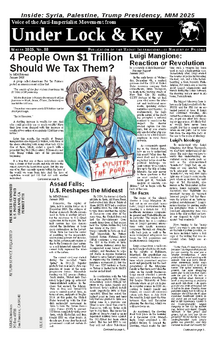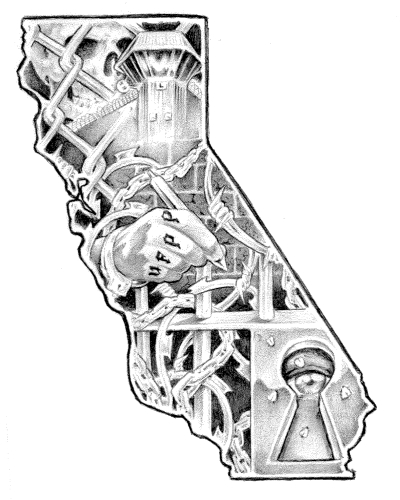
Torture Continues: CDCR Settlement Screws Prisoners
It’s been over a week since we got the news on the settlement of Ashker v. Brown.(1) For a case that is so central to what we do as an organization we’ve taken our time to respond. We’ve read and re-read the legal documents and listened to the celebratory news coverage of the settlement. Yet our reaction remains the same, deep disappointment.
The settlement is a victory for the California Department of Corrections and Rehabilitation (CDCR), and it knocks out one of the three main legs of the campaign to shut down the SHU – the courts (the other two being public opinion and prisoners organized around their own interests). This case had a lot of the known anti-isolation lawyers and some influential long-time SHU prisoners behind it. It was an alliance that will be tough to beat any time soon.
The Maoist Internationalist Movement, along with many other organizations, has spent decades campaigning for the end to long-term isolation in U.$. prisons. We have long countered the public who question us with, “what is your proposed alternative?” with the simple answer, “not torturing people.” Ending long-term isolation in U.$. prisons would be a simple reform that unites the lowest common denominator of prison reformers. Almost everyone agrees we should end torture, and that is reflected in the ongoing movement to do so. It is only the fascist-leaning cop-lovers and state bureaucrats that oppose the call. Actually, in many states the state bureaucrats support ending long-term isolation.
Yet through all the years of struggle here in California, somehow the CDCR has succeeded in painting the ending of torture as the extreme option, with the recent settlement as the sensible compromise. But they are wrong: the extreme option is overthrowing the state and replacing it with one run by the oppressed, where the real killers and exploiters are imprisoned and taught how to live collectively with other humyn beings, not thrown in isolation. Ending torture in prisons is the most basic, sweeping reform that would actually improve the conditions in U.$. prisons.
According to the New York Times, prison directors have become more supportive of reducing the use of solitary confinement after a man who spent 8 years in isolation was released in 2013 and went to the house of Colorado’s prison chief, Tom Clements, and shot him dead.(2) Yet reducing the number of people in long-term isolation only serves to extend the life of its practice as it affects less people and there is less outrage. This reduction also suggests that some people still deserve to be tortured. That is why MIM(Prisons) has never supported measures to get only certain groups out of long-term isolation.
The Ashker settlement has been heralded as “effectively ending indefinite long-term solitary confinement” and “setting strict limits on the prolonged isolation of inmates.” Yet in the actual settlement we read,
“CDCR shall not house any inmate within the SHU at Pelican Bay State Prison for more than 5 continuous years. Inmates housed in the Pelican Bay SHU requiring continued SHU placement beyond this limitation will be transferred from the Pelican Bay SHU to another SHU facility within CDCR, or to a 180-design facility at Pelican Bay. Inmates who have previously been housed in the Pelican Bay SHU for 5 continuous years can only be returned to the Pelican Bay SHU if that return has been specifically approved by the Departmental Review Board and at least 5 years have passed since the inmate was last transferred out of the Pelican Bay SHU.”
That’s it! That’s the extent of the “strict” limitations on long-term isolation in California. So if you’re in another SHU, or Ad-Seg or some other unnamed long-term isolation situation, which about 14,000 of the over 15,000 in isolation in California are, there are no limits.(3) If you’re in Pelican Bay you must move to another SHU after 5 years. Five years later you can come back. Alternatively, you could spend 4.5 years in Pelican Bay, 2 months out, then go in for another 4.8 years, and on like that for the rest of your life. Does this really address the Eighth Amendment claim by the plaintiffs of cruel and unusual punishment? The length often cited for having serious mental affects on humyns is in the range of 15 to 30 days!
Now with the new Step Down Program prisoners are supposed to have a way to return to “a general population setting within three or four years.” So the class of prisoners being represented in this case, those who have been in the SHU for ten or more continuous years, are being addressed adequately according to those who agreed to this settlement. But even moving forward there are exceptions for Administrative SHU Status, allowing people to be held as long as CDCR deems necessary.
There is one progressive concession given in the settlement: “CDCR shall not place inmates into a SHU, Administrative Segregation, or Step Down Program solely on the basis of their validation status.” Additionally, “CDCR shall modify its Step Down Program so that it is based on the individual accountability of each inmate for proven STG [security threat group] behavior, and not solely on the inmate’s validation status or level of STG affiliation.” Finally, as a result of an ending to the indeterminate SHU sentences for prisoners “validated” as members of prison gangs, in the next year “CDCR shall review the cases of all validated inmates who are currently in the SHU as a result of… an indeterminate term that was previously assessed under prior regulations…”
This addresses the Fourteenth Amendment claim that the CDCR was violating due process with the validation system and the use of group punishment, at least somewhat. As we saw a couple years ago, the new STG policy actually opened up STG charges to a wider range of organizations than was covered by the previous validation system. The supposed upside is that the rules require actual STG behavior by the individual to justify placing someone in SHU, not just association. Yet, in the new SHU Term Assessment Chart we see that “Recruiting inmates to become an STG affiliate” is a SHU punishable offense.
As mentioned above, this settlement seems to eliminate the judicial strategy of ending solitary confinement in California for the near future. But it also strikes a huge blow against the strongest leg we have to stand on, the collective organizing of prisoners. Turns out, under the settlement you can expect to spend 12 months in SHU for “Leading a disturbance, riot or strike”, and 6 months for “participation in a disturbance, riot or strike” or “Inciting conditions likely to threaten institution security” (for those not aware, the latter was a common charge made against those who peacefully refused food in recent years to protest long-term isolation in California prisons).
They are outlawing peaceful protest, and non-violent, passive resistance for the prison movement. Amerikans criticize other countries that torture people for peacefully protesting the government that is abusing and, well, torturing them. How is it that leaders in the prison movement have signed on to this?
As we have previously reported, the new STG policies still give prisoners points for things like tattoos, greeting cards and talking to certain individuals. So it is not really true that you can no longer be punished for affiliation. Abolishing this practice was part of the 2nd demand of the hunger strikes.
As a result of reviews (which were mostly underway before this settlement anyway) we have a number of comrades who are getting out of the SHU right now, without having to debrief (snitch). This will no doubt be a positive thing, as we expect many of them will stay politically active in their new locations where they will have more opportunities to reach out to others. Yet at the same time we’ve already seen the next generation of prison leaders going to the SHU. It seems that the youngsters are getting thrown under the bus here.
So this is a wake up call to those not yet in the SHU. In July 2013, 30,000 prisoners stood up against long-term isolation, recognizing their common interests in this demand, even though most of them were not housed in isolation themselves. This was an amazing demonstration that epitomizes the progress made over the last 5 years or so to consolidate the prison movement in California. This continues to be celebrated in the form of the Agreement to End Hostilities and the countless commemorations taking place today, September 9th, in the spirit of peace and solidarity in commemoration of the Attica uprising.
As this settlement was released, public statements from CDCR celebrated it as a continuation of their plan to reform the system after the SHU successfully broke the prison gangs that had taken over. Yeah right. These prison gangs were encouraged by the state who teamed up with white nationalist prisoners to oppress New Afrikans, and later enforced the north/south divide on the Chican@ nation. The continuation of and expansion of united action around the Agreement to End Hostilities is crucial to preventing the CDCR from returning to that status quo.
Leading up to the recent settlement we had one comrade building for a new wave of hunger strikes. As this settlement does not address the most important of the 5 Core Demands, ending conditions of isolation for all prisoners, this call remains valid. And while we’ve always warned comrades to build outside support for such actions, one lesson we can take from California is that such actions must be organized on the inside. Even California Prison Focus, who has been visiting prisoners in the SHU for decades, and who has lawyers with privileged access to their clients, was in the dark during the hunger strikes until the CDCR decided to pull in outside mediators. As always, MIM(Prisons) is committed to supporting the organization of prisoners and fighting to defend the First Amendment rights of prisoners (and ourselves) of speech and association. The ending of a policy that allows the state to torture people for belonging to certain organizations was a blow against the excessively repressive policies of the CDCR in relation to the First Amendment. With this settlement we find California in a similar situation to most of the rest of the country, where torture continues to be the method of choice for population control of the oppressed who do not walk in step with the oppressor.
And so, the struggle continues. Until solitary confinement is abolished, shutting down control units will be a central campaign for MIM(Prisons) and United Struggle from Within.
Campaign info:
California Strike Against Torture in Prisons - 8 July 2013
Related Articles:
- It's Phase Two, We're All Goin' to the SHU
- (Un)Due Process of Validation and Step Down Programs
- STG Pilot Program Primer
- PBSP SHU D-Corridor Hunger Strike
- An Alternative to the SHU
- Fighting STG Status Using Courts and Elections
- "New" Torture Tactics at Pelican Bay
- Support the Illinois Fight Against Solitary Confinement
- The 2 Strikes Law: How it is being used as a revolving door into the abyss of indeterminate SHU terms
- California November Updates: Stamp restrictions, Santa Clara strike success and Ashker settlement update
- More Petty Retribution in Pelican Bay Following Ashker Settlement
- CDCR Not Upholding Ashker Settlement on Due Process
- ASU Prisoners Fighting Torture in California
- Path to Redemption Needed in Texas
- TDCJ Officials DENIED Summary Judgment in Fight to END Restrictive Housing in Texas
- End RHU & All Solitiary Confinement in Texas
- NPR Ignores Torture in United $tates









